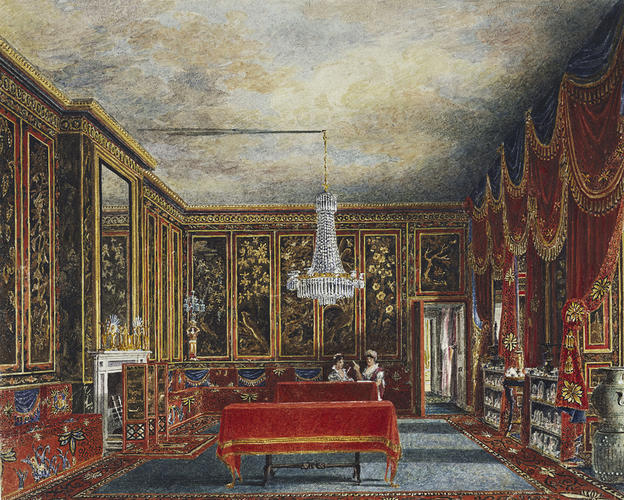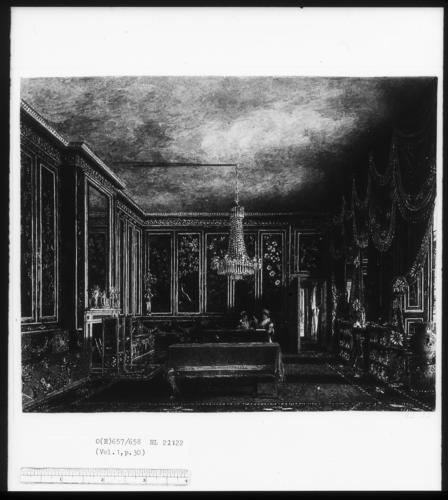Charles Wild (1781-1835)
Frogmore House: The Japan Room c. 1819
Watercolour and bodycolour over pencil | 20.3 x 25.2 cm (sheet of paper) | RCIN 922122
-
A watercolour depicting a fantasy room with painted sky on the ceiling, windows on the right framed by red tasselled curtains, red banquettes round the edge of the room, and panels of black/gold lacquer pictures painted by Princess Elizabeth, daughter of George III. Prepared for one of the plates in William Henry Pyne's History of the Royal Residences (1816-1819). Engraved by R. Reeve, the print published 1.6.1819.
Pyne's History of the Royal Residences was a three-volume publication which encompassed a number of royal residences, including Windsor Castle (vol. 1) and Buckingham House (vol. 2), presenting 100 hand-coloured engravings of exteriors and interiors accompanied by descriptive texts. The 100 watercolours which were engraved for the publication survive in the Royal Library; these watercolours are exactly the size of the image on the printed plates, and may perhaps have been intended as colour guides for the artists responsible for hand-painting the monochrome prints.
Catalogue entry adapted from George III & Queen Charlotte: Patronage, Collecting and Court Taste (London, 2004):
The Japan Room - now the Yellow Drawing Room - is in the centre of the garden front of the ground floor of Frogmore House, looking onto the garden through the colonnade. A drawing by Henry Wigstead, inscribed ‘Frogmore Hall at the Fete 1797’, almost certainly shows this room decorated - with garlands, medallions, urns and trellis-work - for the fête at Frogmore to celebrate the marriage of the Princess Royal to the Hereditary Prince of Württemberg in May 1797. The paper garlands cut by the Princesses and their Windsor friends, and assembled by Princess Elizabeth, had first been used in 1793.
The lacquer panels shown here, which gave the room its name, were painted by Princess Elizabeth. They - or the panels in the Black Japan Room, discussed but not illustrated in Pyne - appear to have been a relatively late addition to the décor for on 19 September 1807 the Princess informed her friend Lady Cathcart: ‘I am busy putting up my Japan room at Frogmore which place is as dear to me as ever’. Some of these lacquer panels are almost certainly identifiable with those in Princess Elizabeth’s married home, the Schloss at Bad Homburg. One of those panels is signed Eliza.
Other decorative work undertaken by the Princess included - at Buckingham House - the seat furniture in the Saloon, upholstered in white cotton velvet and painted with flowers; and the brown and maroon curtains painted in imitation of cut velvet, described in the Queen’s Breakfast Room in 1802. At Frogmore the Princess’s artistic activity could be found in most rooms of the house, and also in the grounds where she designed the Gothic Ruins, with the assistance of James Wyatt. In 1797 the diarist Farington described a ‘long narrow room’ (the Cross Gallery on the first floor) decorated by Princess Elizabeth ‘with painted flowers, & subjects of Children &c cut in paper, & finished by Tomkins’; the connection with the Princess’s silhouettes is clear.Provenance
Probably acquired by George IV
-
Creator(s)
Acquirer(s)
-
Medium and techniques
Watercolour and bodycolour over pencil
Measurements
20.3 x 25.2 cm (sheet of paper)
Other number(s)
RL 22122Alternative title(s)
The Red Japan Room at Frogmore










